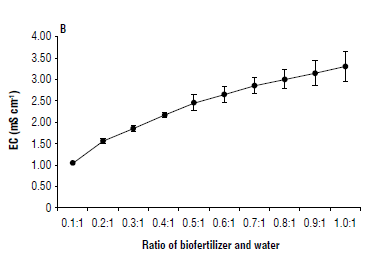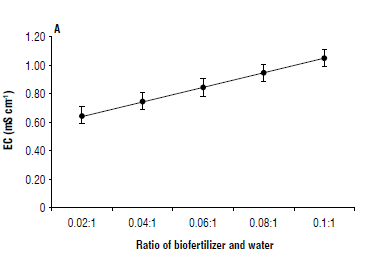Introduction
Biofertilizers are formulations composed of living latent cells of efficient strains of various microorganisms that help plants take up nutrients during the interaction in the rhizosphere. Due to the number of advantages these eco-friendly products are very popular in modern agriculture. Application of biofertilizers reduces and/or totally excludes the amount not only of chemical fertilizers, but also pesticides, insecticides, fungicides, and other chemicals and decrease the dangerous impact of chemicals on the environment. Due to special compositions, biofertilizers improve soil fertility and enhance crop productivity by providing healthy and ecologically safe bioproducts. Application of biofertilizers is an effective approach to sustainable agriculture. Biofertilizers are actively used for rooting cuttings, seed germination, and foliar nutrition (Wong et al., 2015; Alori & Babalola, 2018; González-Díaz et al., 2019). Nowadays, there are various biofertilizers in the global market labeled under different trademarks. The microorganisms of biofertilizers mostly include the N-fixing, P-solubilizing, P-mobilizing, K-solubilizing, S-oxidizing, Zn-solubilizing species, and plant growth promoting Rhizobacteria (PGPR) (Antoun & Prevost, 2005; Fuentes-Ramirez & Caballero, 2005; Vessey, 2015; Anli et al., 2020; Fasusi et al., 2021).
Agriculture in regions with a dry climate may benefit from biofertilizers (Schütz et al., 2018). González-Díaz et al. (2019) observe that biofertilizers inoculated with nitrogen fixing bacteria of the genera Azotobacter and Azospiril-lum contribute to the crop yield of Eucalyptus grandis. In another study (Onyia et al., 2020), growth and yield of maize significantly improve when treated with biofertilizer. Moreover, the applied biofertilizer protect the plants from pathogen/insect attack (Onyia et al., 2020).
Biofertilizers improve soil chemical and physical characteristics including with long-term action (Demir, 2020; Wang et al., 2021). Biofertilizers are effective for application in both open and protected crops (Wu et al., 2005; El-Ghandour et al., 2009; González-Díaz et al., 2019; Demir, 2020; Bergstrand, 2022).
The concentration of supplied nutrients is one of the most important and limiting factors for enhancing the efficiency of plant nutrition. If the concentration of nutrients is extremely low, plant growth is lowered. Extremely high concentrations of nutrients lead to osmotic stress, ionic toxicity, and growth restrictions (Sakamoto & Suzuki, 2020). Optimal concentrations of nutrient solutions (NS) will provide the plants with the necessary amount of nutrients. Two main parameters that best characterize the concentration of NS are electrical conductivity (EC) and total dissolved solids (TDS). Optimization of the concentration of NS is becoming an urgent issue, especially in hydroponics, as the nutrients in the supplied solution remain the main source for the plant nutrition. The EC of NS in hydroponics is in the range 0.8-4.0 dS m-1 (Sambo et al., 2019).
The requirement for a concentration of NS, and therefore of an optimal EC and TDS of the NS, may be different for each plant. For example, Ding et al. (2018) showed that, for the hydroponic production of pakchoi, the optimal EC treatment should be 1.8 or 2.4 dS m-1.
In conventional hydroponic systems, inorganic fertilizers are very common, as organic compounds in the NS inhibit plant growth and have been regarded as phytotoxic (Shinohara et al., 2011). On the other hand, the use of organic fertilizers in hydroponics is important, as it will allow recycling organic compounds. Therefore, the application of biofertilizers in hydroponics remains the focus of the active study (Lee & Lee, 2015; Mendes et al., 2017; Dewi et al., 2021).
Research on several physicochemical parameters characterizing concentrations of NS and uptake of nutrients by the plants remains an actual problem.
In the frame of this study, changes were considered for the two most important parameters: EC and TDS in organic solutions of biofertilizer, depending on the concentration, as well as the role of the solution of the biofertilizer on the rooting capacity of the valuable medicinal plant Callisia fragrans.
Materials and methods
The experiments were carried out at the Laboratory of Plant Nutrition and Productivity of the G.S. Davtyan Institute of Hydroponic Problems (National Academy of Sciences, Republic of Armenia).
In the study, a biofertilizer Ecobiofeed+® was used. It was developed by the "Armbiotechnology" Scientific and Production Center (National Academy of Sciences, Republic of Armenia). This ecologically safe bioproduct, based on natural raw material, contains zeolites and a complex of nitrogen-fixing microorganisms: Azotobacter vinelandii (strain AV1) (Avetisova et al., 2021) and Rhizobiumpusense (strain RP1). This biofertilizer provides plants with macro-and microelements, vitamins, and protein amino acids.
Preparation of nutrient solution
The nutrient solution (NS) was prepared according to the following steps:
A) Ten ml of the biofertilizer were added to the glass container that contains 1000 ml of water (solution A). After the measurements, 10 ml of the biofertilizer were added to the solution A. This process was repeated by adding 10 ml of the biofertilizer each time, until content of the biofertilizer in solution A became 100 ml (solution B). The following ratios (v/v) of the biofertilizer and water were in this prepared solution: 0.01:1, 0.02:1, 0.03:1, 0.04:1, 0.05:1, 0.06:1, 0.07:1, 0.08:1, 0.09:1, and 0.1:1.
B) One hundred ml of the biofertilizer were added to the solution B. After the measurements, 100 ml of the biofertilizer were added to the solution B. This process repeated by adding for 100 ml of the biofertilizer each time, until the volume of the biofertilizer in solution B became 1000 ml. The following ratios (v/v) of the biofertilizer and water were in the obtained solution: 0.1:1, 0.2:1; 0.3:1, 0.4:1, 0.5:1, 0.6:1, 0.7:1, 0.8:1, 0.9:1, and 1.0:1.
Electrical conductivity and total dissolved solids
Electrical conductivity (EC) and total dissolved solids (TDS) of biofertilizer solution were measured depending on the concentration. Measurements were done with the nutrient meter (Bluelab Truncheon Nutrient Meter, New Zealand). Resolution of the equipment was 50 mg L-1,0.1 mS cm-1, and equipment accuracy: ± 50 mg L-1, ± 0.1 mS cm-1.
Rooting capacity
The lateral sprouts (cuttings without leaf rosette) of valuable medicinal plant Callisia fragrans were used. The plants were grown under open-air hydroponic conditions of the Ararat Valley (Karapetyan, 2020). Standard (10-15 cm length) cuttings of lateral sprouts were taken from the plants and immediately placed in plastic cups with a volume of 150 ml (5 cuttings per cup). The cups were filled up with a 120 ml solution of the biofertilizer-water and placed in a laboratory-controlled condition (18-20°C). Rooting was checked up daily. Along with the reduction of the volume of the solution, fresh solution of the biofertilizer-water was added, keeping the total volume at 120 ml. The solution of biofertilizer-water was prepared according to the following ratio: 10 ml of the biofertilizer was added to the 1000 ml of water.
Results and discussion
Electrical conductivity
In nutrient solutions (NS) containing 100 ml of the biofertilizer, electrical conductivity (EC) reached up to 1.05 mS cm-1. Moreover, each 20 ml of the biofertilizer increased the value by 0.1 mS cm-1 (Fig. 1A). Upon increasing the concentration, the EC changed accordingly: the addition of each 100 ml of biofertilizer increased EC from 0.1:1 to 0.2:1 ratio by 0.5 mS cm-1, from 0.2:1 to 0.5:1 ratio by 0.3 mS cm-1, from 0.5:1 to 0.7:1 by 0.2 mS cm-1, 0.7:1 to 1.0:1 by 0.15 mS cm-1 (Fig. IB). EC of water was 0.5 mS cm-1.
Total dissolved solids
In NS containing 100 ml of the biofertilizer, TDS reached up to 525 mg L-1. Moreover, each 20 ml of the biofertilizer increased the value by 50 mg L-1 (Fig. 2A). Upon increasing the concentration, TDS changed according in the following: each 100 ml of biofertilizer added TDS: from 0.1:1 to 0.2:1 by 250 mg L-1, 0.2:1 to 0.5:1 by 150 mg L-1, 0.5:1 to 0.7:1 by 100 mg L-1, 0.7:1 to 1.0:1 by 75 mg L-1 (Fig. 2B). TDS of water was 250 mg L-1.

FIGURE 2 Total dissolved solids (TDS) of biofertilizer solution depending on the ratio (v/v) of biofertilizer and water: A) from 0.01:1 to 0.1:1, B) from 0.1:1 to 1.0:1. Data are the mean of four replicates ± standard deviation.
The changes of the above values were faster in comparatively diluted solutions. Upon increases of the concentration the changes became less. This could be explained by the fact that saturated solutions were created, and further addition of the fertilizer did not play a significant role on the strength level of the solution.
Rooting capacity
After 2-3 d from the beginning of the experiments the cuttings of C. fragrans that were placed in the solution of the biofertilizer-water developed green sprouts. Moreover, within two weeks all cuttings developed roots. In other studies, the efficiency of biofertilizers on the rooting of the plants has also been confirmed. Gortari et al. (2019) prove that mini-cuttings of yerba mate inoculated with Trichoderma asperelloides is distinguished by high rooting capacity as well as a great number and length of the roots. Efficiency of plant growth promoting microorganisms (PGPM) on rooting in plant tissue culture is also approved (Soumare et al., 2021). The rooting percentage of Eucalyptus cuttings increases during interaction between indole-3 -butyric acid and biofertilizer (Rajabi et al., 2015).
Conclusion
The EC and TDS of the biofertilizer-water solution changed gradually depending on the biofertilizer concentration. Moreover, the changes were faster in comparatively diluted solutions, upon increasing the concentration the changes became less. Within two weeks all cuttings developed roots. The measurement of EC and TDS of the applied NS could be important for evaluating the suitability of irrigation. The findings of the present paper are important for the application of biofertilizers in agriculture and provide valuable information.















